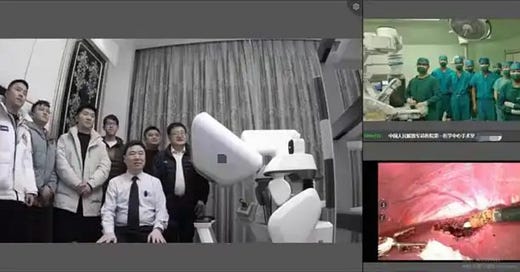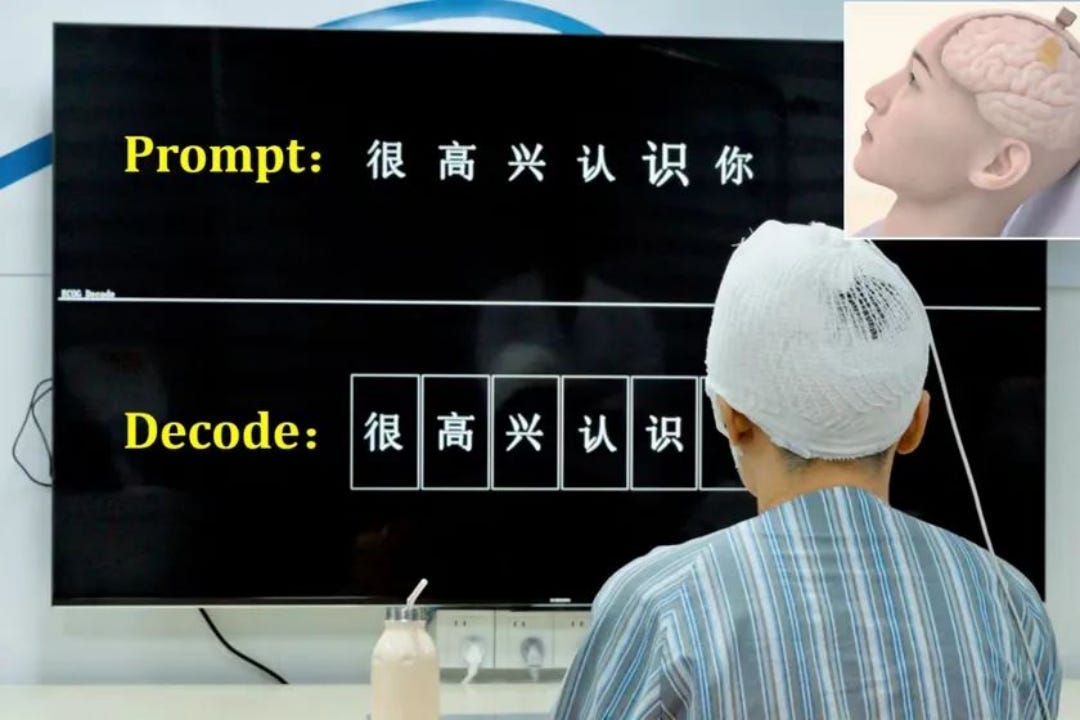A reposting from
Jan 13, 2025
Dear all,
Today, we are covering two medical breakthroughs in China:
A long-distance operation between a doctor in Beijing and a patient in Lhasa, Tibet, spanning 2,800 kilometers.
China’s brain-computer interface helps patients who have lost the ability to speak regain their voice.
The Ultra Long-Distance Operation Aided by Satellite
On January 1, 2023, Professor Liu Rong from the Chinese People's Liberation Army General Hospital successfully performed the world’s first ultra-remote robotic surgery based on satellite communication, using the APStar 6D communication satellite.
In this surgery, the doctor and the patient were located in Lhasa and Beijing, respectively. The surgical robot, controlled by Professor Liu, precisely completed the removal of a liver cancer tumor. The patient has since been discharged smoothly.
The success of this remote surgery is primarily attributed to the APStar 6D communication satellite, which was launched in 2020. Positioned 30,000 kilometers above Earth in geostationary orbit, the satellite offers exceptional coverage, enabling real-time connectivity over thousands of kilometers. To mitigate the risk of satellite communication signal delays, Chinese doctors and satellite scientists collaborated to make technical adjustments in key areas, such as data flow control. These adjustments successfully reduced transmission delays to near the theoretical limit, ensuring that surgical precision was not affected.
According to reports from CCTV, during the surgery, each precise action’s data was transmitted bi-directionally over nearly 150,000 kilometers of space, making it the first such instance both domestically and internationally.
This series of remote liver, gallbladder, and pancreatic surgeries spanned high-altitude plateaus and straits, demonstrating the feasibility, safety, and effectiveness of performing complex and challenging remote surgeries using China’s independently developed communication technology in conjunction with robotic surgical systems. This breakthrough means that patients worldwide now have the opportunity to receive treatment from China's top surgeons remotely.
China’s Brain-Computer Interface Helps Read Patients’ Minds
A Shanghai-based company recently achieved real-time decoding of Chinese language for the first time in a brain-computer interface clinical trial, in collaboration with the neurosurgery team from Huashan Hospital, Fudan University.
The surgery, conducted in December 2024, was performed on an epilepsy patient suffering from a brain tumor located near the language center. The tumor periodically triggered seizures.
The difficulty of the surgery lay in how to completely remove the tumor without damaging the patient's language center. To address this, the surgical team implanted a brain-computer interface beneath the patient’s dura mater and on the cortical surface of the brain.
These brain-computer interfaces will help the patient restore language functions after the surgery.
Specifically, after the brain-computer interface surgery, researchers will assist the patient in completing specific speech tasks. During this process, the patient will repeatedly read aloud or silently recite a series of Chinese syllables. The brain-computer interface device will collect the brain’s electrical signals from the language center in real-time. These signals contain information about the brain’s neural activity when producing specific syllables. By analyzing these signals, researchers can understand the characteristic patterns and regularities in the brain when different syllables are produced, laying the foundation for subsequent speech decoding algorithm training.
After the surgery, the patient achieved a 71% decoding accuracy for 142 commonly used Chinese syllables within five days, with a single-character decoding delay of less than 100 milliseconds. The real-time decoding of Chinese language is now closer to "thought-based speech." As the patient continues using the brain-computer interface and more stable and richer brainwave data is collected, the accuracy of language decoding will improve further.





